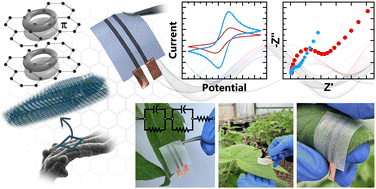Scalable and green formation of graphitic nanolayers produces highly conductive pyrolyzed paper toward sensitive electrochemical sensors†
Abstract
While pyrolyzed paper (PP) is a green and abundant material that can provide functionalized electrodes with wide detection windows for a plethora of targets, it poses long-standing challenges against sensing assays such as poor electrical conductivity, with resistivities generally higher than 200.0 mΩ cm (e.g., gold and silver show resistivities 1000-fold lower, ∼0.2 mΩ cm). In this regard, the fundamental hypothesis that drives this work is whether a scalable, cost-effective, and eco-friendly strategy is capable of significantly reducing the resistivity of PP electrodes toward the development of sensitive electrochemical sensors, whether faradaic or capacitive. We address this hypothesis by simply annealing PP under an isopropanol atmosphere for 1 h, reaching resistivities as low as 7 mΩ cm. Specifically, the annealing of PP at 800 or 1000 °C under isopropanol vapor leads to the formation of a highly graphitic nanolayer (∼15 nm) on the PP surface, boosting conductivity as the delocalization of π electrons stemming from carbon sp2 is favored. The reduction of carbonyl groups and the deposition of dehydrated isopropanol during the annealing process are hypothesized herein as the dominant PP graphitization mechanisms. Electrochemical analyses demonstrated the capability of the annealed PP to increase the charge-transfer kinetics, with the optimum heterogeneous standard rate constant being roughly 3.6 × 10−3 cm s−1. This value is larger than the constants reported for other carbon electrodes and indium tin oxide. Furthermore, freestanding fingers of the annealed PP were prototyped using a knife plotter to fabricate impedimetric on-leaf electrodes. These wearable sensors ensured the real-time and in situ monitoring of the loss of water content from soy leaves, outperforming non-annealed electrodes in terms of reproducibility and sensitivity. Such an application is of pivotal importance for precision agriculture and development of agricultural inputs. This work addresses the foundations for the achievement of conductive PP in a scalable, low-cost, simple, and eco-friendly way, i.e. without producing any liquid chemical waste, providing new opportunities to translate PP-based sensitive electrochemical devices into practical use.

- This article is part of the themed collection: Nanoscale 2023 Emerging Investigators


 Please wait while we load your content...
Please wait while we load your content...